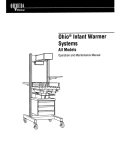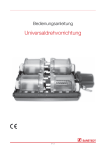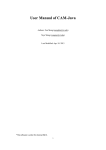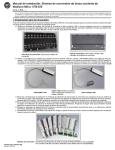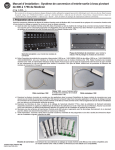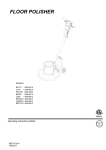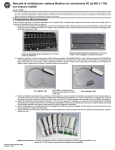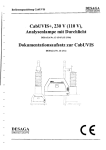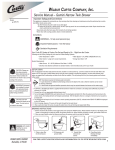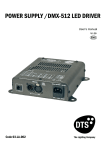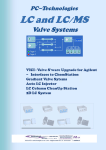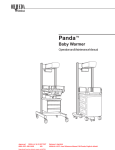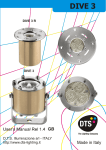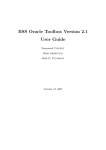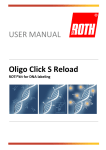Download Method Development Guide v4 December2005 FEW
Transcript
PersonalOPLC50 Method Development Guide OPLC-NIT Ltd. Andor u. 60. H-1119 BUDAPEST HUNGARY v3 (Sept 2004) PN: 100197 TABLE OF CONTENTS 1 Introduction................................................................................................. 5 2 General information .................................................................................... 10 3 2.1 Explanation of Figures ............................................................................ 10 2.2 Techniques ........................................................................................... 10 2.2.1 1D Off-line analysis .......................................................................... 10 2.2.2 2D Analysis ..................................................................................... 11 2.2.3 Bidirectional analysis ........................................................................ 13 2.2.4 Gradient elution (step and continuous) ................................................ 14 2.2.5 Infusion OPLC.................................................................................. 15 2.2.6 Over-running .................................................................................. 16 2.2.7 Multiple Development ....................................................................... 17 2.2.8 Preparative Isolation/Flash Chromatography ......................................... 18 Getting started........................................................................................... 22 3.1 4 The stationary phase.............................................................................. 22 3.1.1 Choosing the stationary phase............................................................ 22 3.1.2 Capacity Guidelines .......................................................................... 26 3.1.3 Handling......................................................................................... 27 3.1.4 Activation ....................................................................................... 28 3.1.5 Prewashing ..................................................................................... 29 3.1.6 Preconditioning ................................................................................ 29 3.1.7 Presaturation .................................................................................. 29 3.2 Sample Application ................................................................................ 30 3.3 Choosing a starting mobile phase ............................................................. 32 3.3.1 A TLC method exists for the samples ................................................... 34 3.3.2 No TLC method is available, but HPLC methods are known ...................... 35 3.3.3 No chromatographic method is available .............................................. 35 Optimizing off-line OPLC separations .............................................................. 36 4.1 Pure, 1-component solvent systems .......................................................... 36 4.1.1 Components near the origin ............................................................... 37 4.1.2 Components migrate to the end of the column ...................................... 37 4.2 Binary solvent mixtures .......................................................................... 38 4.2.1 Case a : My products are behind all demixing fronts............................... 39 4.2.2 Case b : The peaks remain at the head of the column ............................. 40 4.2.3 Case c : The peaks are found at the end of the column ........................... 41 4.2.4 case e : Products are close to or in the demixing front ............................ 42 4.3 Ternary solvent mixtures and beyond........................................................ 43 2/51 5 4.4 Remarks concerning specific solvent systems ............................................. 44 4.5 Remarks concerning reverse-phase separations .......................................... 44 Optimizing on-line OPLC separations .............................................................. 46 5.1 5.1.1 On-line injection with PERSONALOPLC50 (manual or HPLC controlled) ....... 46 5.1.2 The PERSONALOSU50 and FEW TEchnology .......................................... 47 5.2 6 7 Equipment Set-up ................................................................................. 46 Elution Methods .................................................................................... 48 5.2.1 Isocratic elution ............................................................................... 48 5.2.2 Gradient elution............................................................................... 48 References ................................................................................................ 49 6.1 Suggested Reading ................................................................................ 49 6.2 Complimentary Information..................................................................... 49 Glossary ................................................................................................... 50 LIST OF TABLES Table 1. Program parameters for standard 1D OPLC...........................................................11 Table 2. Program parameters for bidirectional analysis......................................................14 Table 3. Relation between Rf and CV.....................................................................................19 Table 4.Recommended max. loading for 0.2µm Silica columns .........................................20 Table 5. LayersTM Columns......................................................................................................24 Table 6. Stationary Phases and their Applications ...............................................................25 Table 7. Volume of Layers Columns (VT) and Recommended Flash Volume (Vr) ..............26 Table 8. Layers Columns and typical max. loading ..............................................................26 Table 9. Eluotropic Series .......................................................................................................32 Table 10. Snyder Solvent Classification ................................................................................33 Table 11. Solvent Miscibility Table ........................................................................................34 Table 12. Starting solvents for Optimization by the Prisma Method ..................................44 LIST OF ILLUSTRATIONS Figure 1. 1D OPLC Off-line separation of components in a plant extract (Atractyloid Root) . Conditions : 5µm of a hexane extract applied in 0.5cm bands (and 2 spots of 1µl). Development with LayersTM LA003 Silica60 and elution with 3ml of a binary gradient Hexane (A) Toluene/3%acetone (B) Densitometric scan obtained with Desaga CD60. ............................................................................................................................................. 6 3/51 Figure 2. 2D graphical representation of 2x1D Analyses for the identification of drugs in urine. Conditions: LayersTM LA001; OPLC solvent 1: 17trichloroethylene: 8MEK: 25BuOH: 6AcOH: 4H2O. OPLC solvent 2: 85nBuOAc: 9.25EtOH: 5Pr3N 0.75H2O.......... 7 Figure 3. 2D Analysis of pentapeptides. Conditions : LayersTM LA001 Silica60; OPLC solvent 1: BuOH: iPrOH: 6AcOH: H2O: pyridine. OPLC solvent 2: BuOH: iPrOH: 6AcOH: H2O. Detection : ninhydrin. Runtime 25mn...................................................................... 7 Figure 4. Illustration of Bi-directional Screening. Flow direction is outwards from a center vertical line, see Figure 9 for details. ................................................................... 8 Figure 5. OPLC analysis of a fraction recovered from a preparative run. Yield >70%, Purity >90% (UV). Conditions: LayersTM LA111 (RP18) used in a gradient analysis with 1-99% ACN (0.1%TFA) at a flowrate of 1ml/min. ................................................. 9 Figure 6. Example of a 1D separation....................................................................................11 Figure 7. Example of 2D analysis ...........................................................................................12 Figure 8. 2D analysis for chromatographic stability determination ...................................13 Figure 9. Preparation of LayersTM column for bi-directional analysis.................................14 Figure 10. Example of over-running to fraction collector....................................................17 Figure 11. Mechanics of a MD band compression. (a) after a 1CV development; (b-d) during second run after drying with (b) solvent front touches back edge, (c) migration of back edge toward front edge begins, and (d) migration of compressed band continues. ................................................................................................................18 Figure 12. Comparison off-line to on-line to show the relation between Rf and the number of column volumes (CV). ...................................................................................19 Figure 13. Example of a label found inside a box of Layers columns .................................28 Figure 14. Effect of presaturation on retention....................................................................30 Figure 15. Effect of the elution power of the solvent during application of a sample ......31 Figure 16. Over-running a 1-solvent system, eventually with fractionation .....................37 Figure 17. Decreasing the mobile phase elution strength. Effect of taking a strong eluting 1-solvent system and adding a non polar solvent in quantities up to 50%.............................................38 Figure 18. Examples of OPLC separations with a binary solvent ........................................39 Figure 19. Off-line Over-runing as a means to use entire column length ..........................40 Figure 20. Increasing elution strength of the mobile phase. ..............................................41 Figure 21. Decreasing the elution strength of the mobile phase. .......................................41 Figure 22. Connection of an injection valve to an OPLC ......................................................46 4/51 1 Introduction The basis of OPLC is similar to that of other chromatographic techniques in that a pump is used to force a liquid mobile phase through a stationary phase, such as silica or a bonded phase media (C8, C18, amino, or nitrile). The uniqueness of OPLC lies in its column housing structure that allows flat, planar columns to be used like cylindrical glass or stainless steel columns. The OPLC terms “ON-LINE” and “OFF-LINE” describe how samples are applied and detected: OFF-LINE meaning that the column is handled outside the development chamber for application of the sample and/or detection; while ON-LINE indicates that the column is left inside the chamber, connected to the injection and detection modules, such as in HPLC. Mixed modes variants are also useful in some applications. The basic OPLC system is the PERSONALOPLC50. It is a stand-alone unit with a single electronically-controlled HPLC pump. This system is most often used for OFF-LINE separations. However, any standard UV detector can be connected to the outlet of the PERSONALOPLC50 should ON-LINE detection be desired. The PERSONALOSU50 unit is simply the column housing part to be installed on an HPLC system. While the PERSONA LOSU50 is designed for ON-LINE analyses, if the HPLC is properly programmed, it can be used for OFF-LINE work, as well. Likewise, the PERSONALOPLC50 can be installed on an HPLC by simply by-passing the OPLC pumping station and connecting the HPLC to the column housing structure. This configuration is not optimal, as the FEW system is not incorporated into the PERSONALOPLC50, however, peak shapes are OFF-LINE mode corresponds to application of the sample directly on the stationary phase, and subsequent analysis of the sample separation on the stationary phase. The different steps of sample application, separation and detection are decoupled in OFF-LINE mode. OFF-LINE application allows the full potential of OPLC flat columns to be exploited. Since the Layers is a semi-disposable column, it is not always necessary to pre-treat the samples before analysis. Crude samples can often be applied directly. The sample application solvent need not be the same as the solvent used for the development, since it is evaporated before the run. Molecules devoid of a UV-chromophore (sugars, lipids, ..) can be detected by using the appropriate post-derivatization, spray-on reagents. And since the amount of time in detection mode can be increased, almost indefinitely, to allow the detection of very low concentrations of sample, off-line detection can be more sensitive. OFF-LINE OPLC analysis and method development are similar to TLC. Several of the techniques used in TLC can be applied to OPLC. However, there are distinct differences 5/51 between the two techniques because of the vapor phase and the role it plays in the chromatographic development. In TLC, solvents in the vapor phase interact with the stationary phase. This is not the case of OPLC which has the stationary phase sandwiched between non-porous materials and the liquid phase pumped from one end of the column to the other. In this non-equilibrated state, gas elimination from the column, solvent vaporization inside the column (before full-development) and selected solvent adsorption can create artifacts that must be understood and corrected by the user. These aspects will be explained in the following sections, as we guide you through basic OFFLINE method development. How you use your PERSONALOPLC50 or PERSONALOSU50 will depend on the type of separation desired : fingerprinting identification screening HPLC method development preparative isolation/flash chromatography Fingerprinting is an analytical methodology where one tries to observe a maximum number of components in a sample in order to distinguish it from other samples of a similar nature. This type of methodology is typical of natural product decoctions where the mixture is a phyto-therapeutic agent containing several components, not of which are identified and where maybe more than one of these components is active. In this case, Figure 1. 1D OPLC Off-line separation of components in a plant extract (Atractyloid Root) . Conditions : 5µm of a hexane extract applied in 0.5cm bands (and 2 spots of 1µl). Development with Layers TM LA003 Silica60 and elution with 3ml of a binary gradient Hexane (A) Toluene/3%acetone (B) Densitometric scan obtained with Desaga CD60. 6/51 the analysis is semi-quantitative or quantitative for the different components. In samples such as these, the different components have very different retention properties. Traditionally, TLC is the method frequently used method to compare sample fingerprints. OPLC systematically shows more resolution than TLC even in initial runs and further improvement is possible by judicious method development. In the following sections, you will observe that changes in the elution power of the solvent will be used to increase retention of fast moving components of a sample, or reduce the retention of tightly retained substances. Several additional techniques are described at the end of this document that can further help in defining fingerprints of product mixtures of this type. These include (1) combining 2 distinct separation methods to characterize the substances; (2) 2D analysis; (3) the use of gradients, either step gradients possible with the PERSONALOPLC50, or continual gradients that require the use of a binary pump. Identification. The following is an example of a the use of two 1D analyses for identifying drug substances (red dot = codeine) from a library of known compounds. In this example taken from the literature, OPLC was used to catalogued more than 210 compounds in a data bank (blue dots in Fig 2) and then use these references to determine if one of these substances is contained in a urine sample. This methodology takes advantage of the sample capacity of OPLC, 15 samples and 3 reference molecules can be run in a single experiment and the results of all 15 are samples are obtained in less than 2h. When increased resolution is needed for a particular sample, 2D OPLC can be of significant help. Figure 3 shows an example of a 2D analysis of a mixture of pentapeptides produced synthetically. Two different solvent conditions ensure different selectivity, thus providing the additional resolution needed to separate these compounds. Figure 2. 2D graphical representation of 2x1D Analyses for the identification of drugs in urine. Conditions: LayersTM LA001; OPLC solvent 1: 17trichloroethylene: 8MEK: 25BuOH: 6AcOH: 4H2O. OPLC solvent 2: 85nBuOAc: 9.25EtOH: 5Pr3N 0.75H2O. Figure 3. 2D Analysis of pentapeptides. Conditions : LayersTM LA001 Silica60; OPLC solvent 1: BuOH: i PrOH: 6AcOH: H2O: pyridine. OPLC solvent 2: BuOH: 7/51 i PrOH: 6AcOH: H2O. Detection : ninhydrin. Runtime 25mn. Screening is a methodology where many samples are analyzed simultaneously on the same Layers TM . Screening requires an established OPLC analytical method. Samples are spotted one next to the other, side by side over the width of a flat column, and eluted simultaneously, and detected on-column (off-line mode). Screening is often performed with up to 50 samples in unidirectional or up to 100 samples in bidirectional modes on a single 20x20 column (see §2.2.2 below). Occasionally, screening can also be done in 2D mode, by combining 2 bi-directional separations in each of the 4 quadrants of a 20x20 layer. step 1 Step 2 Step 3 Step 4 spot 4 quadrants bi-directional remove column, dry, 2nd bi-directional development turn 90°C and insert Figure 4. Illustration of Bi-directional Screening. Flow direction is outwards from a center vertical line, see Figure 9 for details. HPLC Method Development. The OPLC can also be invaluable aid in visualizing the efficiency a separation directly on the column. In HPLC, it is not possible to see what is happening inside the column, whether the components are soon to exit, whether a stronger eluent is needed or whether there are non- migrating products trapped at the head of the column. And it is often with HPLC, we completely ignore any products devoid of a chromophore. With the OPLC open-column design, the separation can be halted and the components visualized directly on the column. If the separation is occurring as desired, then the column is placed back in the machine and the separation is continued on to a detector. If however, there are slowly migrating products, then the column is reinserted and the method is adjusted to push these components down the column. If the components are very difficult to elute, it is always possible to scrape the sample from the column, extract the component, identify it (NMR, IR, MS) and then redevelop a method based on this additional knowledge of the sample. When desired, the column can be treated with a staining reagent, such as a dilute sulfuric acid solution, in order to 8/51 “reveal” UV-inactive substances. Any methodology developed using the OPLC can then be applied in the developme nt of new HPLC routines. Preparative Isolation/Flash Chromatography using OPLC has been exemplified in the literature and how the separation is handled depends highly on the nature of impurities to be removed and where they “appear” in the separation. It is only necessary to develop a method that resolves the product of interest, allowing poorly retained species to be eluted rapidly and efficiently, while maintaining retaining other undesirable components. It is typical to perform sequential isocratic elutions in this type of separation problem. To obtain the best results, it is very important that the product of interest is well behind the slowest moving demixing front (should they appear). Furthermore, the Layers TM column is disposable and therefore does not need to be regenerated, saving time and reducing wastes. Figure 5. OPLC analysis of a fraction recovered from a preparative run. Yield >70%, Purity >90% (UV). Conditions: LayersTM LA111 (RP18) used in a gradient analysis with 1-99% ACN (0.1%TFA) at a flowrate of 1ml/min. 9/51 2 General information 2.1 Explanation of Figures In all of the cartoon illustrations that follow, we use the following color scheme : white for dry stationary phase, while shades of gray for different solvent zones. Colors indicate arbitrary analytes. In all of the figures concerning OPLC, flow is from left-to-right. TLC OPLC Above, we have illustrated a case with a small portion of undeveloped column (white) and only one shade of gray, to indicate that the development has only 1 solvent zone. For the column on the right, 2 shades of gray indicate 2 solvent zones. The intersection of 2 solvent zones is called the demixing front. We shall occasionally make reference to a TLC separation, whic h shall be easily recognized by its orientation (vertical). 2.2 2.2.1 Techniques 1D Off- line analysis Standard 1D OPLC is explained in the operator’s manual. 1D Analysis corresponds to the analysis of 1 to 50 samples, deposited manually or with a spotter, on an Layers column, followed by elution with 1CV of solvent in a single direction to allow migration of the components and separation. One of the more powerful aspects of OPLC is that elution can be continued beyond 1CV of solvent. This is particularly useful when weak eluting solvents are used to separating compounds having very similar selectivity (see also the section on over-running § 2.2.7). 10/51 Figure 6. Example of a 1D separation To ensure the best possible resolutio n, the following parameters are recommended. The development volume values (Vol) for normal phase and reverse-phase columns are slightly lower than the real CV values to ensure that all components of the sample remain on the stationary phase. Table 1. Program parameters for standard 1D OPLC. Pressure 50 bar Flow rate 100-250 µl/min for a 5x20 column 200-500 µl/min for a 10x20 column 400-1000 µl/min for a 20x20 column choose a slightly lower value for viscous liquids Vr (Rapid Vol) 75µl for a 5x20 column 150µl for a 10x20 column 300µl for a 20x20 column Vol solvent for normal phase 900µl for a 5x20 column Vol solvent for RP18 and other bonded phases 600µl for a 5x20 column 1800µl for a 10x20 column 3600µl for a 20x20 column 1200µl for a 10x20 column 2400µl for a 20x20 column For analytical work, it is recommended to use the infusion technique described in section 2.2.5. 2.2.2 2D Analysis The flat, square 20x20cm is the ideal format for 2D Analysis. 2D Analysis is performed only on samples where method development has resulted in one separation method that gives at least partial satisfaction. The program set-up and equipment used for 2D analysis are the same as those used for standard 1D OPLC Chromatography. However, only the square 20x20 column format is used. Te sample is deposited at the left corner at 11/51 1.5cm from each edge of the column. The first separation is performed using the parameters given in Table 1. When the development is finished, the column is removed and dried thoroughly. The pumping system is rinsed with the solvent mixture for the second dimension. The column placed in the cassette so that the results of the first dimensional separation are parallel to the inlet trough of the cassette at the head of the column. The system is then pressurized and the second development is performed. It is possible, when using the bi-dimensional set-up to analyze 4 samples in each of the 4 quadrants of a 20x20 Layers (see Bi-dimensional Analysis §3.2.3). Remember to double the flow rates and the flash volume for bi-dimensional analysis, while the total column volume remains the same. The samples should be placed on the diagonals at 1.5cm from the center. Two examples where 2D analysis is useful : (1) to complete a first dimension in order to separate some partially resolved spots; and (2) to verify the stability of a compound during chromatography. In the first, the objective is to define two distinct, non-correlating solvent systems each with a selectivity as different as possible. In this manner, it is theoretically possible to use the entire 2D-space and to obtain the optimal peak capacity. In practice, it is not always easy to find non-correlating solvent systems for a single stationary phase. More often, the components are spread out over a relatively modest portion of the column. Figure 7. Example of 2D analysis To determine the stability of a compound under specified chromatographic conditions, the same separation conditions are twice but run in orthogonal directions (see figure below). A compound that is perfectly stable to the chromatographic conditions will be found on the diagonally line at the coordinates Rf1, Rf2, where each corresponds to the Rf of a standard OPLC run under the same condition (blue spots designate origin and a stable product). A compound that decomposes partially or completely will show a 12/51 decreased intensity at this same diagonal point, with the appearance of one or more spots at off-diagonal positions (red spots in figure below). Figure 8. 2D analysis for chromatographic stability determination 2.2.3 Bidirectional analysis Bi-directional elution is useful in screening or quantitative analysis of large numbers of samples, or for 4-sample 2D analysis (see 2D Analysis §3.2.2). Bidirectional analysis is a purely off-line analysis performed on 20x20cm Layers columns only. Disconnect the tubing between the pressure sensor on the front of the pumping station and the separation unit and connect to the Tee on the front of the separation chamber. The 2 sides of the Tee should then connect to the inlet and outlet of the separation chamber (Note : In this configuration, there is no connection to waste. The system will automatically shut off when the column is full of solvent and the backpressure reaches 40 bar). Draw a line on the Layers column that divides the column in two equal parts. Samples are placed on each side of the line (1.5cm from the line). The column is placed in the rinsing cassette, also used for bi-dimensional analysis. 13/51 Figure 9. Preparation of Layers TM column for bi-directional analysis. Program the run using the following parameters. Table 2. Program parameters for bidirectional analysis Pressure 50 bar Flow rate 1000-1600 µl/min (2x the value for a standard uni-directionnal run) Vr 600 µl 1CV silica 5000µl, for any column (auto stop will engage when run is finished) Again, it is sometimes more practical to use infusion methods and allow the analysis to stop automatically when the full development length has been reached (see §2.2.7). 2.2.4 Gradient elution (step and continuous) The PERSONALOPLC50 is equipped with three solvent reservoirs that can be used during a programmed run. There is a switching valve located on the side of the machine that is used to select the desired reservoir. These three reservoirs can be used sequentially in a run in order to create distinct solvent changes, known as a step-gradient (Note : The reservoirs can only be used in alphabetic order). Using a step gradient can be useful, for example in preparative isolation. The solvent reservoir A may contain a solvent mixture that elutes all of the poorly retained components of a sample, leaving the compound of interest still within the column. In a second step, the sample of interest is separated from closely migrating species, and finally eluted, perhaps with a third solvent. A step gradient can be used to decrease the importance of the disturbing zone when the components of interest are very close to a demixing front (see § concerning Disturbing 14/51 zone). In this case, the solvent reservoir A is used to fill the column with 1-5CV of a noneluting solvent. Choose the most polar non-eluting solvent, as in §6.1.1 and using Table 4. See Table 3 for CV values of different column types and sizes. After properly filling the column, the eluting solvent is then pumped via reservoir B to elute. Typically, the compound of interest will have a higher retention that when reservoir B is used without prior filling. Therefore, you will probably need slightly more of the eluting solvent than in the original method. Continuous gradient elution is also possible if you have a binary solvent pump to connect to your PERSONALOPLC50. Choose a weakly eluting solvent (Rf 0.1) and a strong eluting solvent (Rf 0.5), as in §6.1.1 and using Table 4. Then, create a gradient with 0-100% of the stronger eluting solvent. Notes/tips on gradient elution : Gradient elution can save time relative to an isocratic separation. Gradient elution is not a substitute for selectivity ! If the components are not separated by an isocratic mixture using the same solvents (at any particular composition), then they will not be separated by a gradient. The starting solvent composition should not elute the components of interest The flow rate can be increased during the part of the separation when the component of interest is highly retained (poorly eluting solvent composition) or after it has been eluted. This technique is often used when there are many components to separate and to wash the column after a run. A steeper gradient can be used when there are few components or a low sample load. 2.2.5 Infusion OPLC Infusion OPLC is performed by placing a stopper at the exit during an OPLC development. Infusion OPLC differs from transfusion OPLC (open exit) by compressing the gases within the layer during an off-line run. The run is automatically stopped when the column is full of solvent and the software detects that the backpressure has exceeded 80% of the compression on the layer. Infusion OPLC has 3 benefits over standard (open-exit) OPLC: no products exit the system 15/51 the reproducibility is improved, since the migration distance of the solvent front is always the same (1CV) regardless of variations in the layer thickness the disturbing zone effects are reduced No products will be eluted since the exit is stoppered. The tolerance of the column volume for 200µm thick stationary phase is ±17%. By using the stopper, the thickness variation or accidental errors in programming are no longer a concern, since the system stops automatically when the column is full. Rf values are much more reproducible since the development length is always the same from run to run. In addition, as the solvent passes through the dry sorbent bed in off-line analysis, air is displaced toward the exit and out of the column. The gas/liquid interface is not totally homogeneous, giving rise to a wiggly solvent front - the disturbing zone. You may also observe that there are two solvent zones on the column that dry at different rates. These two zones are called the “partially wetted” and the “totally wetted” zones. The partially wetted zone, as the name indicates, contains a mixture of solvent, solvent vapor and air around the sorbent. Normally, migrating products are not found inside the partially wetted zone. The solvent front between these two zones is called the total wetness front. If a product elutes close to a disturbing zone, then the spot shape may be deformed by the inhomogeneous flow. Should this happen in practice, the infusion technique should be combined with a reduced elution strength of the solvent so that the analyte migrates well below the diminished disturbing zone. 2.2.6 Over- running Over-running describes the technique of pumping solvents through the column (more than 1CV) until your sample has reached a desired Rf. This is also the technique used when you want to isolate fractions. The following cartoon illustrates over-running. The 1s t column corresponds to 1 column volume of solvent to make a development (1CV), while the second corresponds to 4 column volumes of solvent used. This brings the samples closer to the end of the layer. If we continued on to 6CV, the least retained (red) band will be eluted. This can be done if the red band is not of interest and we wished to obtain better separation of the lower Rf analytes OR when the red band is of interest and we want to isolate and characterize it. 16/51 Figure 10. Example of over-running to fraction collector Since the migration distance is a linear function of the volume of elution in a pumped system, you can easily determine the volume needed to elute components to a predetermined distance. First, you need to know the volume of solvent used for a first separation (v) and the distance that the component of interest travelled from the origin (d1). Choose a distance that the products should migrate to obtain a bet ter result (d2). then you should reprogram the OPLC system for a total elution volume (V) such that V= (v*d2/d1). If you continue to elute beyond this value (V), then the compound of interest will elute from the column. If during this calculation, the column has not been dried, then you can continue by programming the volume difference V-v. If you continue with the same column, but have allowed the column to dry between runs, the compound of interest will be found at a slightly lower distance than the value calculated above. 2.2.7 Multiple Development Multiple development (MD) is a technique wherein a column is developed in off-line mode several times with drying between each run. MD-OPLC has the effect to compress bands that have an Rf>0.5. Band compression is a phenomenon related to the fact that as solvent passes across a band on a dry column, it first touches the back edge. Migration of the back edge then begins before the front edge has even been wetted, bringing them closer together, ie compression. In some instances, this will provide added resolution for the detection of components with nearly identical retention properties. 17/51 (a) (b) (c) Figure 11. Mechanics of a MD band compression. (a) after a 1CV development; (b-d) during second run after drying with (b) solvent front touches back edge, (c) migration of back edge toward front edge begins, and (d) migration of compressed band continues. (d) OPLC-MD was the preferred technique in the detection and quantification of pharmaceutical steroid products (see Pharma Euro 1997, 9, 736). 2.2.8 Preparative Isolation/Flash Chromatography Preparative isolation is illustrated above in Figure 6. Before initiating preparative isolation, you should develop a suitable me thod : on a smaller column with the same stationary phase. Remember that scale-up is direct; you need only change the flow rate and flash volume when increasing the column size. the components of interest are well separated from any demixing fronts that may be present, and preferably, behind them. for convenience, the components should have a reasonable retention factor, 0.2-0.4, so that the amount of solvent needed for elution is equally reasonable (2-5CV). Off-line OPLC can be used to predict the elution behavior using the relationship : CV = 1/ Rf where Rf is the retention factor determined in an off-line OPLC run 18/51 and CV is the number of column-volumes of solvent needed to elute the analyte of interest, regardless of the column dimensions. Table 3. Relation between Rf and CV Rf 0.9 0.7 0.5 0.3 0.1 CV 1.1 1.4 2.0 3.3 10 For a particular set of conditions, a component with an Rf of 0.9 can be eluted with just over 1 CV of solvent, while a component with an Rf of 0.1 requires 10 CV of solvent. CV can be multiplied by the real volume of the column (Table 7) to determine the volume of elution of the analyte. Using the flow rate, calculate the time needed for elution. volume of elution = CV * V retention time = volume of elution / flow rate Figure 12. Comparison off-line to on-line to show the relation between Rf and the number of column volumes (CV). A typical preparative chromatography experiment on an OPLC is performed like this: 1. Determine the volume of the column and the Rf of the sample : apply sample to the stationary phase at 15-20cm from the starting edge of the Layers column. The length of the band should not exceed 180mm. Place a stopper at the end of the column and program a run with slightly more solvent than the actual volume of the column (ie, add 1 ml to the values in Table 1). Perform the run, but remain in front of the machine until the auto-stop function indicates that the pumping was stopped for backpresure reasons. Note the volume value indicated on the display screen. The volume (V) for this column or batch of columns is then 19/51 programmed volume minus the volume value from the display. Determine Rf values , CV values (1/Rf) and elution times of the products of interest. Use these values for fractionation on a second column. 2. Determine approximate loading : In general, as the difference in Rf, and by consequence the difference in CV, between the components increases, the higher the loading that can performed on the column. This is evident, since the sample peaks are farther apart, there is more “space” for peaks that will increase in width (toward shorter retention times) because of overloading. With the CV values from part 1 above, consult Table 4 to estimate the recommended max. loading. 3. Fractionation run : Prepare a column (same batch number as in 1 above) with the desired loading. Note that the quality of the sample application zone has a strong impact on the linearity of the migrating bands and therefore, the purity of the fractions. With substantially increased loading, the back edge of the bands will elute at the Rf predicted above in part 1, however the front edge will be earlier, so begin fractionation 1-2 ml before the expected elution volume of the product of interest. 4. Analyze fractions : spot 1-5µl of each fraction on a column and perform the same method, adjusting the PARAMETER MENU for the size of the analytical column and the desired number of column volumes (CV). Table 4.Recommended max. loading for 0.2µm Layers Silica columns CV < 0.5 2.5 > 4 5x20 2.5 25 50 max loading, mg 10x20 5 50 100 20x20 10 100 200 determined on an PERSONALOSU50 with common organic standards. A few practical notes : • if a programmed run has terminated and interesting components are still on the stationary phase, the column can be reinserted and the programmed run continued, but in this case change Vr=0. If left unchanged, this step in the program will cause an over-pressure and the machine will automatically stop the run. • the cassette has a PTFE cover over the column that is transparent to UV and visible light. Those compounds that have a chromophore (colored, UV20/51 absorbing or fluorescent) can be observed through the cover sheet in order to maintain the column in a wetted state. If a UV absorbing solvent is used (such as toluene, xylene), then UV active substances may not be visible. • a column which has been developed and dried can be reinserted to elute the fractions, but the volume of elution will be slightly more than that calculated above. For example, a compound with an Rf of 0.5 will elute in 2CV, if elution is uninterrupted. However, if the layer is dried after 1CV, 0.5CV of liquid is needed to fill the portion of the column behind the sample, but this does not migrate the sample. Overall, elution will occur at 2.5CV. As the Rf value decreases the difference between a dry column and uninterrupted elution also decreases. • Rf and CV values obtained on a smaller column (5x20 Layers) can be used for a preparative run on a larger column. Remember to reprogram the OPLC to maintain a constant flow velocity. • A glass backed 0.5mm Layers column (ref BSLGP001; Silica60, 22µm) is available for even higher loads. • with off-line sample application, the sample solvent can be evaporated before the run begins. This can be helpful particularly if the sample application solvent causes significant migration in the eluting system. • the PERSONALOSU50 was developed specifically for preparative fractionation using the gradient elution, sample injection an UV-detection functions of an HPLC instrument. • fractionation can also be performed with a series of isocratic elutions, with removal of the column and inspection of eluting bands at regular intervals. This methodology can also help in obtaining a better understanding of the elution properties of a sample and avoid some of the complexities of dealing with demixing phenomena, as described later in this document. 21/51 3 Getting started It is expected that the reader be familiar with the basic operating conditions of the OPLC, including such parameters as flash volume, flow rate and their influence on the linearity of the bands and the efficiency. It is equally important to understand the instrument setup, for standard 1D and for bi-dimensional analyses. In order to get an optimal OPLC separation, we must describe the basics of OPLC method development, and discuss a few phenomena that are directly associated with this technique. This guide is to instruct the user as to the methods and techniques that control the development, such as choosing the starting stationary and mobiles phases adjusting the elution power correcting for demixing optimizing the spread of analytes across the column length 3.1 The stationary phase 3.1.1 Choosing the stationary phase The stationary phase is the key to OPLC chromatography. As a “open” column, it is possible to visualize all substances remaining on the stationary phase at any time during a run. The incorporation of a fluorescent marker facilitates detection of UV-absorbing molecules by a fluorescence-quenching mechanism; a characteristic that make OPLC unique among pressurized-flow HPLC and flash chromatography media. In addition, the cost of the stationary phase is reasonably priced. The column can be discarded after use with crude reaction mixtures or natural product extracts, which often contain a considerable fraction of highly-retained species which would require a significant amount of solvent wash and time to remove. Layers can contain a fluorescent indicator to aid in detection of compounds that absorb at 254nm. In essence, this indicator substitutes for an lamp operated, on-line UV detection system as is used in HPLC. However, with highly polar molecules (polyphenols, for example), it is best to use layers devoid of the indicator which can cause tailing of the peaks. The different types of Layers columns are provided in Table 1. There are very fine- and fine-particle columns with glass- and aluminum-backing, with or without a fluorescent 22/51 indicator, and in different dimensions for different sample capacity. In principal, the 5x20Layers columns are used for : method development analysis of 1-5 samples analysis of crude sample mixtures Layers columns with 20x20 dimensions are preferred for : increase the amount of sample per run (typically up to 100-200mg/run) increase the number of samples per run including standards for quantitative measurements (up to 50 in 1D mode and up to 100 in bi-directional mode) for 2D-OPLC analyses (for up to 4 samples per column) 23/51 Table 5. LayersTM Columns Silica 60 5µm 5µm F254 - Al Al 20x20 20x20 LA 001 LA 1001 5µm F254 Al 10x20 LA 002 5µm - Al 10x20 LA 1002 5µm F254 Al 5x20 LA 003 5µm - Al 5x20 LA1003 Silica 60 5µm F254 glass 10x20 LG 002 C18-Silica60 5µm - glass 10x20 LG 1001 Aminopropyl-Silica60 5µm F254 glass 10x20 LG 502 Cyanopropyl-Silica60 5µm F254 glass 10x20 LA 602 Silica 60 11µm 11µm F254 - Al Al 20x20 20x20 LA 011 LA 1011 11µm F254 Al 10x20 LA 012 11µm - Al 10x20 LA 1012 11µm F254 Al 5x20 LA 013 11µm - Al 5x20 LA1013 11µm F254 Al 20x20 LA 111 11µm F254 Al 10x20 LA 112 11µm F254 Al 5x20 LA 113 Aminopropyl-Silica 60 11µm 11µm F254 F254 Al Al 20x20 5x20 LA 511 LA 513 Silica 60 11µm F254 glass 20x20 LG 011 11µm F254 glass 10x20 LG 012 11µm F254 glass 20x20 LG 111 11µm F254 glass 10x20 LG 112 11µm F254 glass 20x20 LG 211 11µm F254 glass 10x20 LG 212 11µm - glass 20x20 LG 1811 11µm - glass 10x20 LG 1812 11µm F254 glass 20x20 LPG 001 C18-Silica 60 C18-Silica 60 C8-Silica CHIR-Silica 60 Prep Silica60 When using bonded phases in TLC, the capillary action is poor and developments can be long or even impossible. There is no restriction to using bonded phases in OPLC, since it is a pumped flow technique like HPLC. Therefore, the nature of the stationary phase should not be a limitation in your search for an optimized analytical or preparative separation. The optimal stationary phase depends on the nature of the analyte. The following guide lists some known domains of application for common stationary phases. 24/51 Table 6. Stationary Phases and their Applications Phase Typical domaine of application silica separation of polar, acid and basic substances Steroids, unsaturated fatty acids, alkenes C8 and Phase C18 Aminopropyl Reverse several classes of polar and apolar substances fatty acids, aromatic and polycyclic compounds polar compounds phenols, nucleotides, sulfonic acids, carboxylic acids Cyanopropyl amino compounds alkaloids Diol polar compounds Disruptive technologies’ website (www.disruptechno.com) provides more detailed lists of applications, with suggested solvents and stationary phases. This data is based on known literature. Other sources, based on TLC can provide additional starting points for method development. If a special stationary phase is needed, please consult us. We may have what you need in stock (as an experimental layer) or we may be able to produce them in quantities that correspond to your needs. An average column volumes for Layers columns are given in Table 7. The predominant factor is the column size. The volume of the a stationary phase can also vary from batch to batch by as much as 15%, due to variations in the thickness of the layer. On line experiments only use a portion of the total column volume (80-90%) depending on the column dimensions, and these values are also indicated in the table. Be careful to modify the total volume and flash volume when designing an Off-line experiment. Program the OPLC to run to 90% of the real CV, or better yet, use the infusion method when possible to avoid eluting interesting compounds from the column and decrease the disturbing zone (§2.2.7). NOTE : Reverse Phase Media (C8 and C8) which are often used with aqueous mobile phase should always be activated before use in OFF-LINE experimentation, either by heating to 120°C for 30 min. For ON-LINE use, the Layers should be activated, followed by prewashing with a minimum of 7CV of a water-miscible solvent such as acetone or acetonitrile preferably at 1/2 the nominal flow rate. 25/51 Table 7. Volume of Layers Columns (VT) and Recommended Flash Volume (Vr) OFF LINE 3.1.2 ON LINE Vr, µl VT,ml VT,ml 20x20 300 4 3.6 10x20 5x20 150 75 2 1 1.6 0.8 Capacity Guidelines It is difficult to give absolute capacity values that apply to all cases of preparative chromatography and will be applicable to all samples. The amount of product applied to an Layers column depends as much on the outcome desired, as the nature of the sample and the chromatographic conditions applied. The table below provides some guidelines to the typical maximum sample loading as a function of the column width and the retention volumes measured in on-line analyses (see the section on preparative chromatography for more details §2.2.8) with mention to the amount of sample recommended in off-line applications. Capacity is a notion that depends on the sample and the solvent used for the separation. We have used standard compounds in making the determinations that resulted in the following table. In chromatographic terms, the values listed in the first line and for each column of the table below are those found during linear capacity evaluation of the columns. These values apply when off-line sample application is performed. Table 8. Layers Columns and typical max. loading max loading, mg ∆CV off-line < 0.5 2.5 >4 5x20 2.5 2.5 25 50 10x20 5 5 50 100 20x20 10 10 100 200 determined on an PERSONALOSU50 with common organic standards: for Layers Silica60 : isocratic 30% EtOAc in cyclohexane for the analysis of diethylphthalate, butylparaben and hydroxyethylphenol; for reversephase separations 30% ACN in 0.1% aq. TFA for the analysis of methyl, ethyl, propyl and butylesters of phydroxybenzoic acid. Linear capacity is the measure of the maximum amount that can be injected while maintaining a stable retention time (<5% variation) under isocratic conditions. For ∆CV >0.5, these are overloading conditions, where the peak shape may show significant modification. In preparative chromatography, overloading is frequent when peaks are far 26/51 apart (∆CV >0.5). The further they are apart, the more that can be loaded. The last line of the table provides an indication of the max adsorption of an Layers column (total adsorption capacity, dynamic capacity or breakthrough value are terms that have been used to describe this parameter). All of these values are valid for both normal and reverse phase separations. 3.1.3 Handling OPLC Layers columns are fragile, and must be handled carefully throughout the development process. The flat columns are sold in boxes containing 10-20 columns per box. A wax paper separates individual columns in the box. Do not use your fingernail to remove one from the box, as this often results in scratching the surface of the layer, which in turn leads to artifacts during the chromatographic run. Be careful to remove the layers by tipping the box and allowing the columns to fall into your hand. Then gently slide one column from the stack. Immediately close the box, after removing the column to avoid prolonged contact with the atmosphere, as dust, humidity, solvent vapors, etc can deposit on the layer and this may ultimately result in irreproducible results (see also activation § 3.1.3). Each column has an elastomer seal at the edges which must be intact and smooth. Although Disruptive technologies takes care to eliminate any defective column from the production, there may still be damage that has occurred afterwards because of improper handling. Therefore, always inspect the surface of the layer and the regularity of the seal in order to ensure the highest quality results. Slightly damaged columns can however, be used during method development. There is a preferred orientation of the layer with respect to the chromatographic development. Layers 5x20 and 10x20 columns can be fit into their respective cassettes in only one manner, so here, you need not worry. On the inside of the box cover, you will find a label indicating the type of stationary phase, the lot numbers and the date of fabrication. In addition, a schematic drawing shows how the layer should be oriented in the cassette. 27/51 Layers LA 001 Date: 07 11 2003 Charge n° OB 324 333 Layers thickness: 170-180 µm Sealed by OPLC -NIT Proposed direction of development Figure 13. Example of a label found inside a box of Layers columns In one of the 4 corners of the column the seal forms a cross. This cross should always be placed at the exit side of the cassette (on the left for a 20x20 Layers), so that the flow of solvent through the column respects the direction indicated by the arrow on the box cover (see illustration below). 3.1.4 Activation Activation is the term used for drying the Layers columns prior to use. This should be done at 120°C for no more than 30min. Activation has 2 roles. First, activation removes excess moisture from the sorbent layer. In adsorption chromatography, the term activity is used to describe the absorption characteristics of the stationary phase. High-activity sorbents retain molecules more strongly, while less active sorbents retain only weakly. In order to improve the reproducible of your results, it is best to have a well-defined level of activity (moisture) on the sorbent. Other techniques, such as preconditioning, presaturation or impregnation (not described herein; see a text on TLC for specific applications), have been used to control the surface properties of the sorbent in TLC and obtain specific results with certain analytes. These techniques are applicable to OPLC, however there have not been any detailed studies that allow us to suggest how to perform these techniques in an effective manner. The second role of activation is to improve the mechanical properties of the binder used to maintain the silica gel on the aluminum or glass backing. The binder is a water-soluble polymer, which is slightly hygroscopic. During storage and handling, the binder can soften because of moisture it picks up from the atmosphere. Activation 10min at 120°C removes the water from the binder and restores the binder’s properties. Reverse Phase Media (C8 and C8) which are often used with aqueous mobile phase should always be activated before use. In on-line work, a solvent-based “activation”, ie. prewashing with 5-10 CV of a water- miscible solvent such as acetone or acetonitrile, can be equally important for dehydrating and stabilizing the binder. 28/51 3.1.5 Prewashing OPLC Layers columns are coated with surface active sorbents (silica, RP-silica…), which pick up not only water, but also “dirt” contamination from the air. The surface layer also contains a binder that may contain some components that are soluble in certain polar solvents and which can concentrate to form dirty zones on a developed place. Prewashing is the terms used to remove these impurities from the column before development. Prewashing will provide a more uniform background and better baseline during densitometric analysis. Prewashing is essential for quantitative measurements, as well as trace analysis and stability testing. Pre-washing can be done : by dipping, 1-7min in pure MeOH solvent, or by the “TLC method”, allowing methanol to migrate through the phase and push the impurities to the end, or by the “OPLC method”, rinsing in OPLC conditions with 2-5 volumes of methanol. After washing, the columns should be thoroughly dried before use. If the columns are not used immediately, they should be stored with an appropriate protection to avoid recontamination. For example, cleaned columns can be wrapped in clean aluminum foil and stored in desiccators. 3.1.6 Preconditioning Pre-conditioning differs from pre-saturation in that the objective is to modify the stationary phase with a substance that is not part of the eluting solvent. This technique is not used in initial method development and requires a detail understanding of the sample. Pre-conditioning more often refers to partial to total saturation with an aqueous phase. Partial saturation can be obtained using aq. saline solutions. 3.1.7 Presaturation The role of presaturation is to induce solvent vapor to interact with the stationary phase prior to development. Consider the following cartoon where the TLC conditions are compared to OPLC without presaturation and with presaturation prior to development. With presaturation, the demixing zone is removed (only one shade of gray is shown to indicate a unique solvent zone). After presaturation, solvent is adsorbed to the active sites of the st ationary phase. This results in a reduction in the activity of the sorbent toward the polar component of the mobile phase, which now remains constant 29/51 throughout the separation. Presaturation has also resulted in a modification/deactiviation of the stationary phase relative to the analyte molecules, which also migrate faster in this system. OPLC without presaturation OPLC after presaturation with the mobile phase Figure 14. Effect of presaturation on retention To do presaturation in OPLC, prepare a TLC tank with 20-30ml of the solvent mixture at the bottom. Place a beaker or bottle in the tank on which to lay the Layers and a piece of filter paper along the inside of the tank to speed the saturation of the vapor phase with the solvents. Place the Layers column in the tank, cover and leave for 10 min to 1h. Do not allow the Layers to contact the solvent directly nor the wicking paper. During the presaturation period, prepare the OPLC with the solvent (TLC) mixture. When the saturation period is finished, bring the column holder (cassette) next to the presaturation tank, remove the Layers and place it immediately in the OPLC cassette and firmly hold the PTFE sheets closely over the column. Put the cassette in the machine as soon as possible and perform the development. As mentioned before, you will often find that the products migrate at a higher Rf(OPLC) and that the demixing zone has been eliminated. In many cases where presaturation is done prior to the separation, the best mobile phase for the OPLC development will contain less of the polar component of the mixture used for presaturation. For example, if you saturate with a mixture of 20% MeOH in Toluene, then try 10% MeOH or pure Toluene for the separation of the sample. 3.2 Sample Application Off-line sample application is a very flexible technique, since the solvent is eliminated by evaporation and will not interfere with the separation. When depositing a sample, try to choose a volatile solvent that does not elute the analyte under TLC conditions. Figure 2 below illustrates this aspect of sample deposit as a function of the elution strength of the solvent. Analytes remain at the center of the application zone when a poorly eluting 30/51 solvent is chosen for sample application (left side). When a highly eluting solvent is used for application, the analytes will migrate as the solvent passes into the stationary phase and the spot will become larger and more diffuse. This can have a significant effect on the final peak shape after the analysis. Automated sample application is the best way to deposit accurate quantities of sample on the sorbent phase for subsequent quantification. Automatic sample application with a Desaga AS30, for example, can greatly improve the aspect of the band shapes. Manual application of samples should be done using a capillary tube for TLC or a microsyringe. The sample should be applied at 2cm from the bottom edge of the plate, and no closer than 1.5cm from the edge of the layer (0.5mm from the inner edge of the seal). Be careful when doing manual application as the capillary can scratch the surface of the layer which lead to small artifacts in the final development. Before beginning the development, the sample spot should be well dried. Any residual solvent may affect the separation. Always prefer air drying at room temperature. Do not use a hot air dried, as this can lead to reaction chemistry, degradation and/or irreversible binding to the stationary bed. Figure 15. Effect of the elution power of the solvent during application of a sample As a final note, off-line analyses can also be performed with on-line injection via an autosampler or a manual injection valve. This can be an attractive alternative to manual sample application and is often used for preparative separation. With on-line injection, the stationary phase is equilibrated with the solvent before injection. As is mentioned several times in the following text, equilibration of the phase before injection can alleviate many problems related to the disturbing zone and demixing. It will also affect the retention factor (Rf), since equilibration deactivates the stationary phase making it 31/51 less retentive. In this respect, on-line injection resembles pre-saturation conditions (§ 4.2.4). 3.3 Choosing a starting mobile phase In normal phase (silica) chromatography, non polar substance elute before polar substance, and the development distance is a function of the polarity of the solvent : the more polar the solvent is, the further the samples will migrate for a given volume of solvent used. Halpaap’s Eulotropic Series (Table 4) is an accepted indication of solvent “elution strength”, to be used in method development on normal and reverse phases. Safety precautions will preclude using certain solvents in these lists, such as benzene, CCl4 and diethyl ether. However, as these may have been used in past literature, the values included in these tables may be helpful in developing a new method. Table 9. Eluotropic Series Solvent Pentane Hexane Iso-octane Cyclohexane Carbon tetrachloride l-Chlorobutane Xylene Toluene* Chlorobenzene Benzene Ethyl ether Dichloromethane* Chloroform* 1,2-Dichloroethane Methyl ethyl ketone Acetone Dioxane 1-Pentanol Tetrahydrofuran* Methyl t-butyl ether Ethyl acetate* Dimethyl sulfoxide Diethylamine Acetonitrile 1-Butanol Pyridine 2-Methoxyethanol n-Propyl alcohol Isopropyl alcohol Ethanol Methanol Ethylene glycol Dimethyl formamide Water ε° (SiOH) ε° (C18) 0.00* 0.00-0.01 0.01 0.03 0.11 0.20 0.22 0.23 0.25 0.38-0.43 0.32-0.32 0.26 0.47-0.53 0.49-0.51 0.53 0.48 0.38-0.48 0.50-0.52 0.60 0.70-0.73 - _ _ _ _ _ _ _ _ _ _ _ _ _ _ _ 8.8 11.7 3.7 3.1 10.1 8.3 3.1 1.0* 7.6 - 32/51 The eluotropic strength is not the only factor to be considered in developing a method, especially when the sample mixture contains several analytes, where, selectivity is equally important. As an aid, Snyder classified all common organic solvents into 8 groups according to their polarity, H-donor and H-acceptor properties. In theory, it is possible to construct different solvent systems from the different groups that are similar in eluotropic strength, but can have different selectivity for the analytes. Table 10. Snyder Solvent Classification Group solvent type solvent strength 1 alkanes 0 ethers 2.1-2.8 2 common alcohols 3.9-5.1 3 THF 4.0 pyridine 5.3 methoxyethanol 5.5 Acetic acid 6 formamide 9.6 5 chlorinated solvents 3-3.5 6 ethyl acetate 4.4 ketones 4.7-5.1 dioxane acetonitrile 4.8 5.8 aromatic hydrocarbons 2.4-2.7 nitrobenzene 4.4 chloroform 4.1 nitromethane 6.0 water 10.0 4 7 8 Because OPLC uses only a small volume of solvent in off-line mode it may be possible to consider less-common liquids as solvents, that otherwise are not used in HPLC or TLC, because they are not habitual (cyclohexene, for example), they may be corrosive (such as with solutions where the pH<2 or pH>8), or they generate high backpressures (ie, butanol). 33/51 Table 11. Solvent Miscibility Table 1 2 3 2 3 4 4 5 6 5 6 7 8 7 8 9 9 10 11 10 11 12 13 12 13 14 14 15 16 15 16 17 18 17 18 19 19 20 21 20 21 22 23 22 23 24 24 25 26 25 26 27 28 27 28 27. di-iso-propyl ether 27. Xylene 26. Water 25. Toluene 24. Tetrahydrofuran 23. Pentane 22. Methyl ethyl ketone 21. Methyl-t-butyl ether 20. Methanol 19. Isopropyl alcohol 18. Iso-octane 17. Hexane 16. Heptane 15. Ethyl ether 14. Ethyl acetate 13. Ethanol 12. Dioxane 11. DMSO 10. DMF 9. Dichloromethane 8. 1,2- Dichloroethane 7. Cyclohexane 6. Chloroform 5. CCl4 4. Butanol 3. Benzene 2. Acetonitrile 1. Acetone 3.3.1 A TLC method exists for the samples Developing a method with OPLC can be easier when the separation conditions for the sample are known in TLC. A rapid literature search should help you to find conditions that work in TLC (solvent and stationary phase). Several TLC methods exist, choose the simplest one as a place to start. Keep in mind that OPLC development is more sensitive than TLC. 1-solvent systems are much easier to transpose from TLC to OPLC. 2-solvent systems are more complicated because of the phenomenon of demixing which may occur. Some TLC systems are particularly challenging, especially when NH3 or NH4OH are included in the mobile phase. See section 4.1.4 for these specific cases. If the TLC system is abased on a single solvent, see section 4.1. 34/51 If the TLC system is based on a binary solvent system, see section 4.2. There are limitations of using TLC to predict OPLC conditions, particularly with solvent mixtures containing a small amount of a very polar co-solvent, such as methanol or acetone. If your compound has never been separated by TLC, then you will have to develop a solvent system for your separation, see section 4. 3.3.2 No TLC method is available, but HPLC methods are known If the TLC conditions are unknown, search for HPLC methods. This will give an idea of the type of stationary phase and solvent needed for the separation. In many instances, you will find that HPLC methods were developed with reverse phase media. While reverse phase is rarely used in TLC because capillary forces are weak and therefore, mobile phase velocity is very low. This is not a problem in OPLC, since the flow is maintained by pumping. Whether developing from normal or reverse phase methods, it is best to start by activating the column for 10min at 120°C. Since HPLC methods often use gradient elution, guess at a reasonable isocratic solvent mixture for the OPLC method to be developed. Perform an OPLC run based on this assumption, then use the following sections to optimize the separation should you encounter : low Rf values (increase the elution strength using Table 9), the presence of a demixing front (see § 4.2.2 or Presaturation §3.1.7), samples at the solvent front (decrease the elution strength using Table 9). You may also want to develop an on-line injection method with either on-line or off-line detection. Equilibrate the column with 7CV of the eluting solvent prior to injection (with a manual valve). For reverse phase separations involving an aqueous mobile phase, it is best to begin with a prewash using 7CV of the dry organic solvent before equilibrating with the eluant system. 3.3.3 No chromatographic method is available It is best to begin by testing different pure solvent in TLC conditions. The proceed to a binary mixture if a satisfactory result is not obtained. See the following section 4.2. 35/51 4 Optimizing off-line OPLC separations It is difficult to cover all cases of separations in this preliminary guide. This is especially true of normal phase OPLC chromatography where the number of possible solvents combinations is almost limitless. Two factors must be considered when using this guide, the optimum separation must take into account the position of the analytes on the column and the selectivity in separation that is desired. For samples where purity checks are being performed, there may be only a few products in the mixture and/or the impurities may be similar in nature, and it may be necessary to resolve only the component of interest. In other cases, such as in the fingerprinting of natural product extracts, there can be up to thirty or more compounds in the sample. The structural differences in these substances make it a challenging problem to obtain satisfactory migration and selectivity of as many of these components as possible, especially those that characterize a specific property of the species or a particular extract. Therefore, before optimising any separation, it is first important to define the objectives (analytical, preparative, fingerprinting, screening) as this will help you to focus on the components of interest and the type of separation that is required. 4.1 Pure, 1-component solvent systems One-component solvent mixtures are ideal for OPLC, since demixing phenomena are not possible (Note : If you do see a demixing front, this indicates that the solvent may be contaminated). When the TLC conditions call for a pure solvent as the mobile phase, the OPLC separation will typically work using identical conditions. To develop a new OPLC method, based on a 1-solvent system begin by spotting your sample on a silica gel TLC plate. Place it in a beaker containing a relatively poorly eluting solvent (low eluotropic value in Table 9) and begin the TLC. Refer to the following illustration. If migration does not occur, dry the TLC plate and this time, try the TLC with the next more polar solvent found in Table 9. Continue down the table, noting the extent of the development, until a solvent polarity is reached where the development is above Rf 0.2 (case 2). Note this solvent. Spot the sample again and continue down the table until a solvent is identified that pushes the products to Rf 0.8 (case 4). Note this solvent as well. The optimization will be performed on solvents listed between the two solvents noted above. If by chance, one of the separations is similar to case 3, this of course, will be the starting point for the optimization in OPLC. 36/51 There is no need to optimize the TLC solvent system yet, since the results with the OPLC may be slightly different (higher or lower Rf). Optimization will be done with the OPLC instrument. Attempt a run on the OPLC with the solvent system that gave the best result using the parameters described in Table 1. 4.1.1 Components near the origin If the separation is low on the TLC plate (Rf< 0.3), but there is sufficient selectivity, you can do over-running in order to push the sample further on the OPLC column (as in the illustration below and described in §2.2.6) or you can choose a stronger eluting solvent from Table 4 and try again. For normal phase, take a solvent lower down in the list. Figure 16. Over-running a 1-solvent system, eventually with fractionation 4.1.2 Components migrate to the end of the column If you components are at the column exit and there is little separation, you should dilute the solvent with a less polar solvent that does not cause significant migration (binary mixture) or choose a single solvent with a weaker elution strength. 37/51 By adding a small amount of a non-eluting solvent, the retention will be increased, the components will migrate slower and selectivity can increase. With a judiciously chosen non-eluting solvent, detrimental effects of demixing and disturbing zones can be minimized. Prefer a non-polar, poorly eluting solvent that has a polarity and viscosity properties that are as close as possible to that of the migrating solvent. Figure 17. Decreasing the mobile phase elution strength. Effect of taking a strong eluting 1-solvent system and adding a non polar solvent in quantities up to 50% If after several trials, a satisfactory solution is not found, proceed to the following section (§4.2) to construct a binary mixture. More likely than not, you will have to make mixtures of the different solvents in order to obtain the optimal selectivity. 4.2 Binary solvent mixtures If you are developing your own method from scratch, then you will likely develop a method without presaturation as a first place to begin. As a solvent mixture is being used, demixing will likely occur and the proper corrections to the solvent phase will be needed. The optimization of the method will require adjusting the retention with respect to the Rf of the demixing front. The same is true, if you are using a literature method based on a 2-solvent system. We shall apply the method directly on your OPLC without presaturation and then look at the following figures. If you are coming from § 4.1, choose one good-to-poor eluting solvent from your solvent range determination that provides a short than optimal migration distance and add to this a good-to-overly strong eluting solvent that pushes the products closer to the solvent front. Mix them in a 50:50 mixture and begin the OPLC separation. Depending on whether the separation goes too far on the layer (too much polar additive) or not far enough (not enough polar modifier), you should adjust the solvent ratio to move the analytes into the central portion of the column. It is strongly recommended to use only solvents of similar polarity in approx. equal proportions to avoid demixing zones in the heart of the separation zone (for example, prefer toluene/ethyl acetate 60:40 to hexane/acetic acid 90:10). The following illustrates what you may observe : 38/51 (a) The separation is OK, but only a portion of the column is used. (b) The products are very close together and very close to the head of the column. (c) The products are poorly retained in this system and the separation is unsatisfactory. (d) The separation is OK, but only the starting portion of the column is used. (e) Some or all of the products are in the demixing front Figure 18. Examples of OPLC separations with a binary solvent We shall discuss each of these cases in turn. Of course, it you have already obtained a satisfactory separation at this point, your search is over. It is possible to reduce, and often eliminate demixing altogether by presaturation. We will different techniques that can be used to solve these problems. 4.2.1 Case a : My products are behind all demixing fronts Sometimes demixing is not a significant problem as your samples are below the demixing front (see cartoons a and d). In these two cases, the products are distributed between Rf = 0 and the demixing front. The next improvement of the separation, which will better exploit the full length of the column, is to continue to elute beyond the plate length, ie, over-running (see in §2.2.6). You should not add more of the polar solvent to the solvent mixture as this will typically decrease the resolution of the analytes and can push them closer or into the demixing zone. Over-running describes the technique of pumping solvents through the column until your sample has reached a desired Rf. This is the technique used when you want to isolate fractions. The following cartoon illustrates over-running. The 1s t column corresponds to 1 column volume of solvent to make a development (1CV), while the second corresponds 39/51 to 4 column volumes of solvent used. This brings the samples closer to the end of the layer. If we continued on to 6CV, the least retained (red) band will be eluted. This might be done if the red band is not of interest and we wished to obtain better separation of the lower Rf analytes OR when the red band is of interest and we want to isolate and characterize it. Figure 19. Off-line Over-runing as a means to use entire column length Since migration is a linear function of the volume of elution, this is easy to determine the volume of solvent that needs to be introduced to bring the least retained band to a desired distance. First, you need to know the volume used for the first separation (v, 1CV in the example here) and the distance (d1, Rf=0.2) that the band(s) of interest travelled from the origin. Choose a distance that the products should migrate to obtain a better result (d2, =0.8). then you should reprogram the OPLC system for a total elution volume (V) such that V= (v*d2/d1), or 4CV. If you continue to elute beyond 5CV, then the compound of interest will elute from the column. 4.2.2 Case b : The peaks remain at the head of the column You may attempt over-running (§2.2.7). Increasing retention is one way to improve selectivity. Combining over-running and a high-retention method is a powerful technique that TLC cannot perform and can provide spectacular results. If even after several volumes of solvent over-running, the bands are still slowly migrating, it is better to increase the proportion of the strongest eluting solvent in the composition (for example from 20% to 40%). Increasing this will cause the samples to migrate faster, maybe coming closer to the demixing front. If too much polar modifier is added then the samples may be pushed into the demixing front, resemb ling case e (§4.1.2). 40/51 case (b) effect of progressively increasing the quantity of the most eluting component of the solvent mixture Figure 20. Increasing elution strength of the mobile phase. 4.2.3 Case c : The peaks are found at the end of the column If the sample is migrating farther than you desire, then decrease the amount of the strongest eluting component of the solvent mixture. Decreasing the amount of polar modifier will decrease the migration distance, as well as the lowering the demixing zone on the column at the same time. The end result may be a better separation (f and g) or your samples may remain together, just behind the demixing front where they still are only poorly resolved (h). case c (f) (g) (h) Figure 21. Decreasing the elution strength of the mobile phase. 41/51 If the situation remains similar to case c, then continue to decrease the amount of the most eluting constituent of the solvent mixture. Of course, if you arrive at case (f) you have finished. If you obtain (g), over-running is a very adequate solution to improve the separation (§2.2.6 and above). If instead, the products are getting closer or are in the solvent demixing front, then you must change solvents. If you have attained the limit of 20% of the most eluting solvent and you have obtained no better separation, you will also have to change your solvent system (§ 4.2.4). 4.2.4 case e : Products are close to or in the demixing front Your present method shows a demixing zone and your samples are near it in some unsatisfactory way (for example, as in (e) or (h) below). You will probably already have tried decreasing the amount of the most polar constituent of the solvent mixture which has not worked. case (e) or (h) You must change the nature of the polar organic modifier. There are no fixed rules for what solvents to use as replacements for others. Remember, the objective is to move the sample analytes behind and away from the slowest moving demixing front. We can always use over-running to then exploit the full length of the column. The location of the demixing front is a function of the polarity difference between the polar and non-polar components of the solvent mixture and the relative proportions of each. If we use a less polar modifier in the proportions as before, the demixing front will be at a higher Rf value on the layer, while the analytes will be at a lower Rf value. Overall, these two effects are ADDITIVE, and both help toward the objective. Once the compounds are behind the slowest moving solvent front, we can choose whether to increase the proportion of the new polar modifier or increase the volume of elution (over-running) to obtain a satisfactory separation. If we consider the arguments above, we can also see why decreasing the elution strength by changing the apolar component for a less polar one is not often fruitful. In this case, the difference in polarity of the two solvents in the mixture increases, which leads to a demixing front at a lower Rf. The compounds will also migrate to a lower Rf value because of the weaker elution strength of the mixture. The two effects are not in synergy and the result is not predictable. 42/51 Use the Eluotropic Series (Table 9) and Snyder’s Solvent Classification Tables to guide you in selecting a slightly different solvent mixture. If you are working from a known TLC method and are having problems with demixing as described here above, then you may have solvents whose strength are too different. TLC is much more tolerant of disparate solvent strengths. Rreplace the more polar component in the mixture with a slightly less polar one and increase its proportions. As an example, 5% methanol can be replaced by 25% ethyl acetate, 20% MEK or 15% acetone, as a starting point. Begin with an examination of different solvents with intermediate elution strength (§4.1.1) in order to obtain a better understanding of the polarity range for your product. Be aware that when changing chemical families of polar solvents, you will likely change the selectivity (for more information on the eluent and their polarity, refer to the Table 9). If however, a method based on simple or binary solvents cannot be obtained see section 4.1.3; for the method of constructing a ternary solvent system. 4.3 Ternary solvent mixtures and beyond If despite hard work, a method based on simple or binary solvents cannot be obtained, choose solvents from three different Snyder Groups and prepare a 1:1:1 mixture. Depending on the results in OPLC, either adjust the composition (more or less of the more Eluotropic solvent) adjust the solvent strength by the addition of a non eluting solvent, or reconsider the choice of the stationary and mobile phase altogether. Use the same techniques as described in the previous sections to guide you through this optimization. You may also consult more intensive documentation concerning solvent families and selectivity using the PRISMA model, as proposed by Nyiredi, etal (see §6) for normal phase separations. Essentially, the method begins with TLC analysis in order to select three solvents which give an 0.2<Rf<0.8, provide high peak numbers (if needed) and good band shapes (little or no tailing). By using three solvents, you ensure that the each of the three fundamental characteristics that contribute to retention/elution (dipole interactions, H-bonding and H-donor) are independently variable. The addition of a noneluting solvent as a fourth component, allows you to adjust a fourth variable, the elution strength. The method is quite elaborate, but has an excellent track record. Depending on 43/51 visual observation of the separations, three or four solvents are selected for optimization according to a multi-variant parameter method. Table 12. Starting solvents for Optimization by the Prisma Method Group solvent solvent strength 1 di-iso-propyl ether 2.8 2 2-propanol 3.9 ethanol 4.3 3 THF 4.0 4 Acetic acid 6 5 Dichloromethane 3.1 6 ethyl acetate 4.4 7 Toluene 2.4 8 chloroform 4.1 We suggest, that you refer to the original texts for help. We can also assist you during this method development stage. The PRISMA method is an excellent method that takes into account the different interactions and solvent strength parameters in order to optimize the selectivity. It is an excellent method when a large number of molecules must be separated, but it requires patience and can take several days to complete. 4.4 Remarks concerning specific solvent systems Never use phosphoric acid as part of the eluting system. If acid modifier is needed prefer acetic, formic or trifluoroacetic acids. Avoid the use of ammonium hydroxide as part of the eluting system in an offline experiment. Prefer pyridine or triethylamine as a pH modifier. Some reverse-phase methods will require that 0.1% formic or trifluoroacetic acid be added to the solvent system because the media are not end-capped and contain residual silanols. 4.5 Remarks concerning reverse-phase separations Reverse-phase separatio ns function by interaction of molecules with hydrophobic sites on the stationary phase. Migration occurs due to a competition between the solvent and the analyte molecules for the hydrophobic site. It follows that it is the less polar solvent that 44/51 is the stronger eluting component, in contrast to normal-phase chromatography. In OPLC, there are a few special considerations when performing RP chromatography, Activation of the stationary phase is required. This can be done either, by thermal activation in an oven at 120°C for 30min, or by solvent dehydration inside the OPLC by washing the stationary phase with 5CV of the pure (watermiscible) organic solvent. Activation improves that mechanical stability of the column layer. If the column is used in on-line mode with repeated injections, it is necessary to include a dehydration step at the end of the run before reequilibrating at the injection conditions. The use of 0.1% trifluoroacetic acid (TFA) is recommended, as it has an effect that lowers the backpressure inside the column and reduces potential interactions between the analyte and residual silanols on the stationary phase (present Layers TM columns are not end-capped). Formic acid may be substitute for TFA, but avoid the use of phosphoric acid. Small partic les may break free of the stationary phase during an experiment, especially if the column has been poorly handled (scratches or rubbing can free small particles). The tubing exiting the OPLC should be 0.25mm (0.1”) or larger in diameter to avoid plugging, or choose to use a frit at the exit to protect detectors and fraction collectors placed downstream of the unit. 45/51 5 Optimizing on-line OPLC separations On-line OPLC has at least chromatographic separations. 2 significant advantages over standard HPLC for First, the column can be removed and observed by a number of different methods, which include UV observation, scanning densitometry, fluorescence imaging, TLC-type revelation with colorimetric reagents and bioautography. These help to gain a better understanding of the elution properties of a compound or complex mixture, so that the chromatographic method can be improved to obtain the desired objectives (analytical detection, screening, preparative isolation, etc). Second, since the column since the column is disposable, it is possible to perform sample prep or fractionation directly on crude sample mixtures containing metal catalysts, resins or tars, which would otherwise damage a more expensive HPLC chromatography column. 5.1 5.1.1 Equipment Set-up On- line injection with PERSONALOPLC50 (manual or HPLC controlled) On-line injection with an PERSONALOPLC50 can be performed by simply disconnecting the tubing between the separation unit and the pressure sensor on the front of the pumping station. Insert the injection valve here. Connect the injector to the separation unit according to the following scheme. Take out the housing screw on the side of the pumping station and fix the injection valve here. Figure 22. Connection of an injection valve to an OPLC Only 1 sample can be analyzed at a time with an OPLC in on-line mode. The sample can be injected either onto the dry column or after column equilibration. As with all on-line injection techniques, the solvent used to transfer the sample to the stationary phase must not cause significant migration of the compounds. Furthermore, with the OPLC it is possible to elute through a detector (UV, Evap. Light Scattering Universal Detector or LCMS). 46/51 Dry column injection minimizes solvent waste, but decreases reproducibility, while the opposite is true for equilibrated column injections. To do dry column injection, prepare the system for a run. With the pump still off, fill the loop and turn the valve to the inject position. Begin the development. To equilibrate a column, use a minimum of 7CV of the solvent for the initial phase of the separation. The OPLC can also be inserted into an HPLC system in place of the column, with the injector feeding into the entrance of the PERSONALOPLC50 and the exit of the OPLC connected to the detector system. Remember that the safety features of the PERSONALOPLC50, cassette detector and the backpressure shut-off, are not fully operational in conjunction with an HPLC, so be careful to ensure that the cassette is in-place and compressed to 50 before pumping solvent and to adjust the backpressure limit on your HPLC to 40bar (580psi). 5.1.2 The PERSONALOSU50 and FEW TEchnology The installation of the PERSONALOSU50 on an existing HPLC station is described in the PERSONALOSU50 User's Manual. The PersonalOSU50 incorporates the FEW technology which provides better resolved peaks by eliminating wall effects which modify fluid flow. In order for the FEW Technology of the PERSONALOSU50 to be effective, the tubing setup should follow the diagram below. There is a Tee on the front of the PERSONALOSU50. The pumping station should feed directly into the Tee (the Tee can be removed from the front of the machine in order to place it nearer the injector and minimize tubing). The Tee splits the solvent into 2 streams : one for the FEW (left most connection on the front panel) and the other leads to the injector and back to the PERSONALOSU50 inlet. The flow resistance from the Tee to the PERSONALOSU50 can adjusted to give optimal performance by the proper choice of tubing which depends on the column size. This should be done in conjunction with our service agent. 47/51 5.2 5.2.1 Elution Methods Isocratic elution On transferring a method from off-line OPLC to on-line OPLC, you will probably observe that the bands are less retained and that there is a slight loss in resolution. For best results in this transfer, the Rf values of the products of interest in off-line OPLC should be less than 0.3 and behind any demixing fronts. Behind the demixing fronts, the column is in near equilibrium conditions, and samples found here should be easily resolved in online OPLC. With an Rf=0.33, the elution volume will be slightly less than 3x the column volume, which is directly related to k' in HPLC, which is =3 in this case (k' =1/Rf). 5.2.2 Gradient elution Gradient elution is often necessary when analyzing complex samples which contain components with a wide spread of retention characteristics, as in natural product extracts. In this c ase, gradients for on-column detection are necessary to resolve 48/51 6 6.1 References Suggested Reading E Tyihak, E Mincsovics “Overpressured-layer Chromatography (Optimum Performance Laminar Chromatography/OPLC)” in Planar Chromatography : A Retrospective View for the Third Millenium Sz. Nyiredy, ed, Springer, Budapest, 2001, Chapter 8, Nyiredy, Sz “The Bridge between TLC and HPLC : Overpressured Layer Chromatography (OPLC)” Trends in Analytical Chemistry, 2001, Vol.20(2), 91101. Nyiredi, Sz; Dallenbach-Tölke, K; Sticher, O . “The Prisma Optimization System in Planar Chromatography” J Planar Chromatography 1988, 1, 336. see Disruptive technologies’ website (www.disruptechno.com) for more literature concerning particular applications, OPLC technology and innovation. 6.2 Complimentary Information “Efficiency characterisation of off-line infusion and conventional transfusion OPLC” Planar Chromatography, Lillafüred, Hungary 24-26 June 2000, p. 109119 Applied Thin-Layer Chromatography : Best Practice and Avoidance of Mistakes E.H. Deinstrop, ed, Wiley, Weinheim Germany, 2000. Practical Thin Layer Chromatography B Fried, J Sherma, eds. CRC Press, London, 1995. Colorimetric Reagents for TLC, published by Grafis, Frankfurt, Germany for E Merck gives a comprehensive list of spray on reagents. see Disruptive technologies’ website (www.disruptechno.com) for more literature concerning particular applications, OPLC technology and innovation. 49/51 7 Glossary ACTIVATION. Activation corresponds to heating the Layers layer for 30 min at 120°C in an oven in order to remove moisture from the layer. Activation can also help by stabilizing the binder used to maintain the stationary phase on the support. BONDED PHASES. These are chromatographic media that have been silanized to obtain functionalized silica. Typical bonded phases include : RP8, RP18, cyanopropyl, aminopropyl, phenyl, etc.. COLUMN VOLUME or CV. This refers the amount of solvent to fill the column once completely olvent. This is equivalent to t0 (dead volume) in HPLC. DEMIXING. Describes the preferential depletion of a solvent from a mixture of solvents making up the mobile phase as it crosses over a non-equilibrated stationary phase. For a polar stationary phase, the more polar component is preferentially adsorbed to the stationary phase, lowering its concentration in the mobile phase. The opposite is true in reverse phase mode. If demixing occurs, you may be able to see it even in the absence of an analyte, since the solvent zones usually have different refractive indices. In other instances, for example the column is not prewashed and a polar solvent such as acetone is used in the mixture, “dust impurities” may accumulate at the interface of the demixing zones leaving a yellowish line. For relatively clean layers, the line is usually not visible even with the aid of a UV lamp (and layers with a fluorescent indicator). For more information see Disruptive technologies Note on Demixing. DENSITOMETRY. Diffuse Reflectance Scanning UV Spectroscopy on an OPLC layer, a technique used to detect sample analytes on an OPLC layer. A densitometer can be used to obtain full UV-spectra of samples on a layer, or it can be used in single wavelength mode to selectively detect samples with known UV- maxima. DISTURBING ZONES. Close to the solvent migration front (wet and dry interface) or near a demixing front, where flow may not be homogeneous. Disturbing zones can be responsible for wiggly or diffuse bands. Adjust the solvent compositions to keep analytes away from these portions of the layer. ELUTION. Movement of a sample band through the column and out to detectors or fraction collectors. GRADIENT. The composition of the solvent changes during elution, either by a step (rapid change to a second composition) or a linear change (gradual and continual change in composition, as typically done in HPLC). 50/51 ISOCRATIC . a single solvent or solvent mixture is used to elute, ie the composition does not change during the separation. MIGRATION. Movement of a sample band along the column. OFF-LINE. Off-line mode corresponds to sample application or analyte detection directly on the layer. ON-LINE. On-line sample application refers to using an injector valve, while on-line detection refers to eluting the analyte to a detector, UV, ELS, MS or other system. PEAK CAPACITY. Peak capacity refers to the number of resolved spots that can be obtained on 1 column length in off-line mode. PRESATURATION. Passive saturation of the adsorption sites on the layer with solvent vapors by placing the layer in a closed vessel with the solvent mixture to be used for the chromatographic analysis. In some instances, presaturation is performed with a different solvent mixture, this is more often referred to as conditioning. RAPID VOLUME or “Flash Volume”. In order to obtain an optimal flat migration front, it is necessary to program a rapid solvent injection at the start of the experiment, called the “Rapid volume” or Vr (see PERSONALOPLC50 User Guide). This is particularly true for large column widths (A20). The flash volume establishes a homogeneous flow over the width of the column. RETARDATION FACTOR of Rf. the distance a substance has migrated on a layer (d) relative to the distance travelled by the solvent (Ds ). Rf = d/Ds . Rf is related to k’ in HPLC by the equation k’=(1/Rf)-1 SOLVENT STRENGTH. refers to how the polarity of a solvent changes the ability to dissolve a compound. In chromatography, increased solvent strength corresponds to a solvent that reduces the retention time by increased solvation of a compound. SELECTIVITY. ability to dissolve compounds of same polarity to a different extent. In chromatography, this refers to the partitioning between the mobile and stationary phase which is different for molecules with the same polarity. 51/51



















































